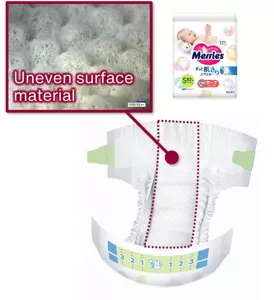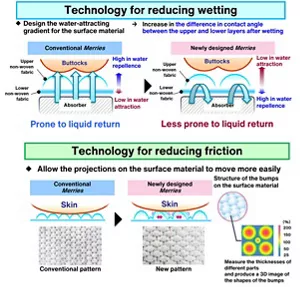Innovation for Better Skin Health: Developing Merries to Bring Smiles to Babies and Parents
Diaper Development
For parents and babies, the greatest source of worry about diapers is diaper rashes. This is because baby skin is only half as thick as adult skin, making it very delicate.
There are two major causes of diaper rashes. One is hydration of the horny layer when the diaper is wet or full. The other is peeling of the horny layer caused by friction between the skin and the diaper.
To solve these problems, we worked to develop a special surface sheet with an uneven surface for Merries that reduces the two problems.
First, to reduce hydration of the horny layer, it is important to reduce liquid return from diapers.
We therefore focused on the difference in contact angle between the front side and back side of the surface sheet through which we repeatedly ran artificial urine, and found that there is a correlation between the contact angle difference and the amount of liquid return. Then, by coating the fibrous surface of the surface sheet with a newly developed water-attracting agent to closely control the degree of water repulsion, we could reduce the amount of liquid return by around 45% and increase the rate of skin moisture by approximately 35%.
Next, to reduce peeling of the horny layer, it is important to reduce the friction between the skin and the diaper.
To develop a sheet that hugs the body in a flexible way when it moves, and reduces the area of contact between the diaper and the skin at the same time, we examined the surface area and stiffness of the projections and their air content, and then designed an optimal pattern. As a result, we were able to reduce the coefficient of friction by about 15% and the amount of horny layer peeling by around 20%.
We want to produce diapers that are reliable for parents to use, comfortable for babies to wear, and keep them all smiling. With this concept in mind, we will continue to develop diapers for babies that make skin health a priority.


- Home
- Innovation
- Research & Development
- Product Development Research
- Sanitary Products
- Innovation for Better Skin Health: Developing Merries to Bring Smiles to Babies and Parents
- Home
- Innovation
- Research & Development
- Product Development Research
- Sanitary Products
- Innovation for Better Skin Health: Developing Merries to Bring Smiles to Babies and Parents
